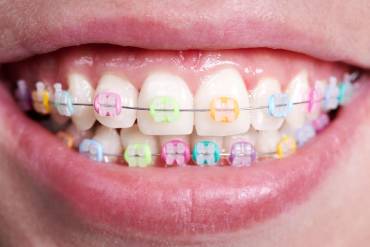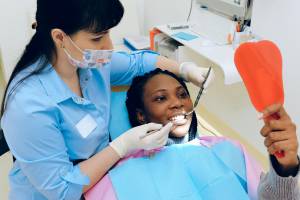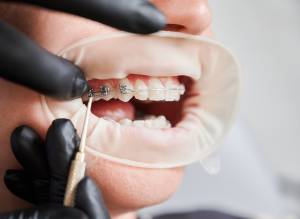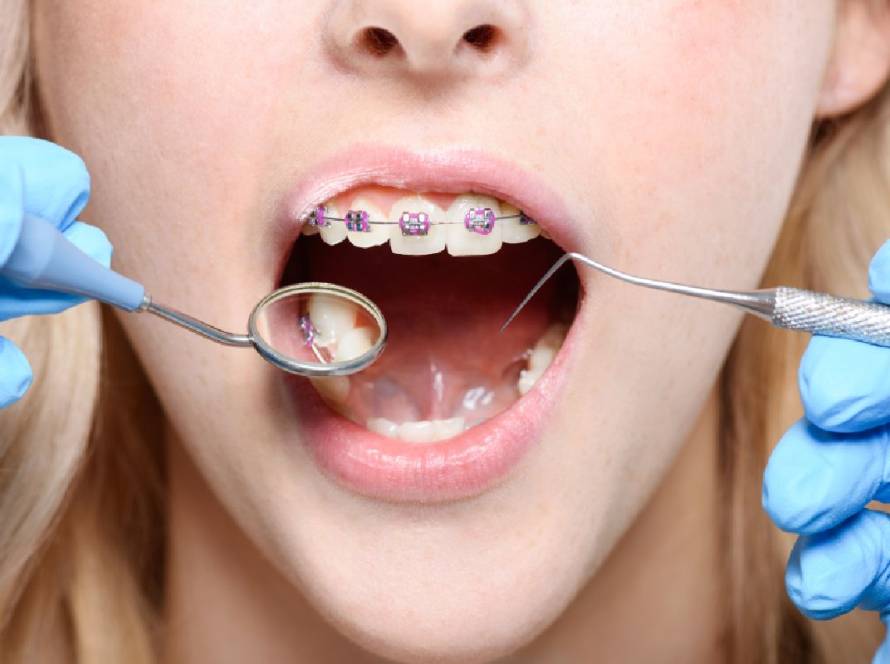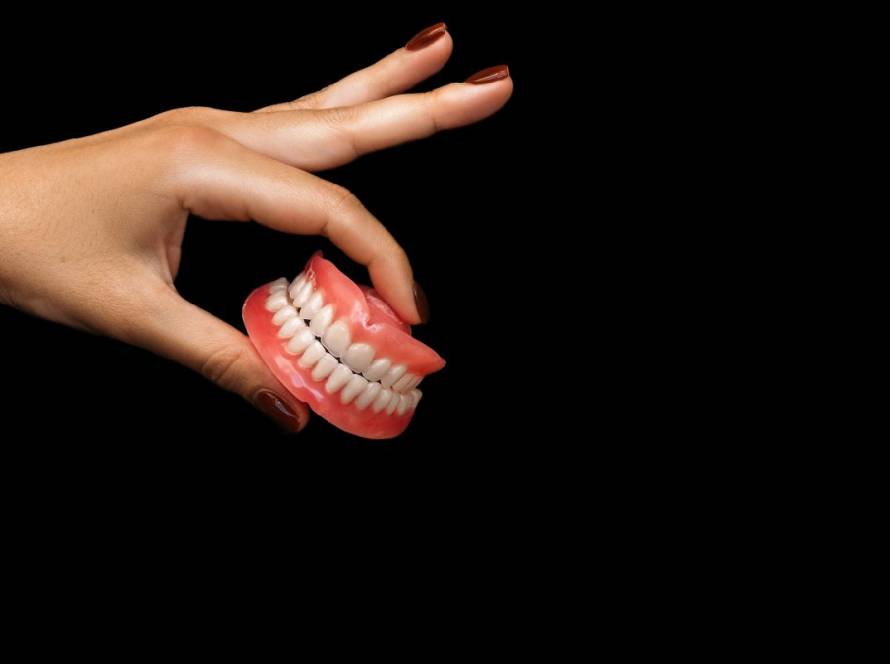Did you see your favorite TikTok influencer post a do‑it‑yourself braces video and decide you wanted to try it? Bad idea. No, it is not safe to do dental braces yourself, and there is a long list of reasons why you should bin that plan.
If moving teeth were as simple as wrapping a band around them or gluing on a bracket, dentists would not spend years learning the biology, physics, and planning that make orthodontics work. This guide explains what those videos never mention, what can go wrong without professional care, and how to straighten teeth safely.
Key Takeaways
- DIY braces, gap bands, and at‑home glues can cause irreversible damage, including gum injury, root resorption, tooth loss, and bite problems.
- Tooth movement is a controlled medical process that requires diagnostics, sterile technique, and ongoing monitoring.
- Mail‑order aligners are not the same as doctor‑supervised orthodontics, and they carry risks when used without in‑person exams and X‑rays.
- If you want a straighter smile, professionally made clear aligners or braces are the safest path.
- Nassau Bay Dental offers comfortable, modern orthodontic options, with financing through Sunbit and most insurance accepted.
Why People Try DIY Braces
Trends catch fire online because they promise a shortcut. The idea of straightening teeth at home, saving money, and seeing quick results feels tempting.
Many creators show easy, upbeat videos that skip the hard parts, like pain, complications, and the cost of fixing the damage. Before you follow a trend, it helps to understand what real orthodontic treatment involves and why quick hacks backfire.
Orthodontics Is Biology and Engineering, Not a Craft Project
It is easy to underestimate how complex tooth movement is. Teeth sit in bone, supported by a living ligament that responds to pressure over time.
To move a tooth safely, a clinician must calculate the right amount of force, the right direction, and the right timing. Too much force, the wrong angle, or pressure on a diseased tooth does not speed things up, it causes injury.
Before any movement starts, dentists and orthodontists perform a full diagnostic workup. That usually includes a comprehensive exam, periodontal evaluation, digital X‑rays, and often 3D imaging or impressions.
They check for cavities, gum disease, root length, bone levels, impacted teeth, jaw relationships, and airway issues. With that data, they map how each tooth should move, in what sequence, and how to keep the bite stable when treatment ends.
Yea, it’s as exhausting as it sounds. And needless to say, none of that can happen in a bathroom mirror with a phone camera.
What Counts as “DIY Braces” and Why Each Method Is Risky
Not every at‑home tactic looks like a full set of braces. Many trends use everyday items or unregulated kits. Each one has its own pitfalls, even if it seems harmless at first glance.
Gap Bands or Hair Ties
People loop tiny rubber bands around teeth to close spaces. Those bands can slide under the gums without you feeling it, cut the blood supply to the ligament, and loosen the tooth. Teeth can drift, tip, or even fall out. Closing one space this way can create new spaces and a bite that no longer fits.
Super Glue and Stick‑On “Brackets”
Using household glue to attach brackets or decorations to teeth feels clever until it burns gums, traps bacteria, and damages enamel. Some glues release heat and toxins as they cure. When you pull the piece off, the enamel often comes with it, leaving a permanent scar or a fracture.
Unregulated Online Braces Kits
Kits shipped without in‑person exams skip the crucial step of confirming that your teeth and gums are healthy enough to move. Without X‑rays, there is no way to see bone loss, short roots, or impacted teeth. Moving teeth blindly can shorten roots, increase mobility, and inflame gums. If trays or wires are the wrong shape, they push teeth in the wrong direction and make the bite worse.
Mail‑Order Clear Aligners
Some companies offer remote aligner treatment with minimal or no office visits. While aligners are a legitimate tool in a dentist’s hands, using them without in‑person exams, periodic checks, and updated scans is risky. If attachments are placed wrong or not used, if tooth movement stalls, or if gums react poorly, no one catches the problem until damage shows. A pretty smile with a broken bite is not a win.
DIY 3D‑Printed Aligners
Tech‑savvy users sometimes print their own trays using scanned models. Without medical training, they often over‑trim edges, create sharp borders, and design movements that overload the teeth. Materials not meant for oral use can irritate tissues, and non‑sterile production introduces bacteria into an appliance you wear for hours.
What Can Go Wrong When You Move Teeth Without a Dentist
Every shortcut has a catch, and with teeth the catch can be expensive and permanent. Even when the front teeth look straighter, damage may be building under the surface.
- Root resorption, the body dissolves the root when force is wrong or too strong, shortening the tooth’s foundation.
- Gum recession, bands and hard edges cut the gums, exposing root surfaces and causing sensitivity.
- Bone loss, inflamed tissues and excessive pressure reduce the bone that holds teeth in place.
- Tooth mobility and tooth loss, loosened teeth shift or fall out when the supporting structures fail.
- Cracked enamel and cavities, glues, constant friction, and trapped plaque erode enamel and lead to decay.
- Bite collapse and TMJ pain, moving a few front teeth without coordinating the whole bite creates new interferences, jaw strain, headaches, and clicking joints.
- Infections and ulcers, non‑sterile materials injure soft tissues and let bacteria flourish.
- Choking hazards, small parts can dislodge during sleep and enter the airway.
Fixing these complications often requires gum grafts, root canal therapy, crowns, extractions, implants, or full orthodontic retreatment. That is a lot of risk for a trend.
The Hidden Costs of DIY Braces
DIY looks cheap until the repair bills arrive. Replacing a single damaged tooth with an implant and crown costs far more than a supervised orthodontic plan.
If several teeth shift out of position, you might need braces, bite therapy, and restorative work just to get back to a healthy baseline. Add in time off work, discomfort, and the stress of uncertainty, and those shortcut savings disappear.
Why Professional Supervision Changes Everything
Professional orthodontic treatment is not just a nicer version of a home project, it is an entirely different process. In‑office exams allow your dentist to catch early signs of trouble, such as inflammation, decalcification, or slow‑moving teeth.
Digital X‑rays and 3D scans guide safe movements. Custom appliances, whether braces or clear aligners, distribute force properly and protect the bite. Regular check‑ins keep your plan on track and comfortable.
At Nassau Bay Dental, we use modern diagnostics to plan every step. Digital X‑rays reduce radiation and provide immediate clarity. Intraoral cameras let you see what we see. 3D imaging improves the precision of aligner and implant planning.
Laser dentistry helps us treat gums comfortably when needed. All of this helps you get a straighter smile without unnecessary risks.
Is Mail‑Order Orthodontics the Same as In‑Office Care?
It can be confusing when ads promise the same results without appointments. Remote systems cannot provide periodontal exams, take professional X‑rays, or adjust your plan in real time when biology behaves differently than the software predicted.
For some mild cases, aligners can work beautifully, but the safest route is to begin with a complete dental evaluation and to follow a plan monitored by a doctor who can examine your teeth and gums in person.
Safer, Effective Alternatives to DIY Braces
If your goal is a straighter, healthier smile, you have options that work and protect your teeth.
- Professional clear aligners, custom‑made trays guided by a dentist move teeth predictably and discreetly.
- Limited or phased orthodontics, for small cosmetic tweaks, we can often plan a shorter treatment that focuses on your top concerns.
- Pre‑orthodontic health tune‑up, treating cavities, cleaning gums, and polishing enamel before movement improves comfort and results.
- Retainers and minor corrections, if your teeth have only shifted a little, a retainer plan may recapture alignment without full treatment.
A quick consultation helps us match the right approach to your smile, your schedule, and your budget.
What to Expect When You Straighten Teeth at Nassau Bay Dental
Starting treatment should feel simple and stress‑free. We keep it that way. Your first visit focuses on listening to your goals, checking oral health, and taking any needed images.
We discuss options that may include clear aligners and restorative touches if chipped edges or uneven enamel need smoothing. You will see what your smile can look like and how long it may take. Most plans fit easily into busy lives, and our team stays in touch so you are never guessing what comes next.
Financing and Accessibility
Great care should be within reach. Nassau Bay Dental accepts most major dental insurance plans. We also offer flexible financing through Sunbit so you can start now and pay over time. If a dental problem cannot wait, we provide same‑day emergency appointments and sedation options to keep you comfortable.
Final Thoughts
DIY braces might make for catchy videos, but your teeth are not a weekend project. Teeth move inside living bone, and the forces that guide them need professional planning and oversight. When shortcuts backfire, the damage can be permanent and costly. If you are serious about a straighter smile, partner with a dental team that treats the whole picture, not just the front view.
Nassau Bay Dental delivers safe, modern orthodontic solutions tailored to your life. We welcome patients of all ages, we accept most insurance, and we offer Sunbit financing to make treatment accessible. Call or text us, book your visit, and let us help you reach your goals the right way, with comfort and confidence.
FAQs
Is it ever safe to use rubber bands to close a gap?
No. Bands can slip under the gums, damage the ligament, and loosen or even remove a tooth. The risk is not worth it.
I only want to straighten two front teeth. Do I still need a dentist?
Yes. Moving any tooth affects your bite and gums. A quick exam and a simple plan can correct small concerns safely.
Are mail‑order aligners safe?
They can work for some people, but skipping in‑person exams and X‑rays increases the risk of gum problems, root shortening, and an unstable bite.
What if I already tried a DIY method and my teeth feel loose?
Stop immediately and call a dentist. Early care can sometimes stabilize teeth and prevent permanent damage.
How long will professional treatment take?
That depends on your bite and goals. Minor corrections may take a few months, while comprehensive plans take longer. The key is safe, steady progress.
